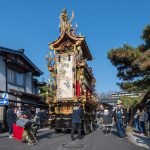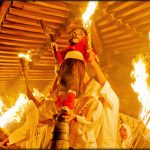The Tejikara Fire Festival is held each year on the second Saturday of April at the Tejikara-o Shrine in the heart of Gifu City. This centuries-old tradition is a spectacle of flames that illuminates the night skies and draws spectators and participants into a vivid tapestry of fire, faith, and community. The Tejikara Fire Festival is a significant intangible folk cultural festival that expresses Shinto beliefs. The festival’s rituals invoke divine blessings for prosperity, good harvests, and protection. Fire, considered a purifying element in Shintoism, symbolizes renewal and cleansing the community of impurities while warding off evil spirits.
Schedule
The Nagamochi entrance will begin in each town at 2.30 pm. The decoration of the mikoshi entrance will end at 6.45 pm, followed by the lighting of Gohei lanterns at 7 pm. At 7.25 pm, the waterfall fireworks will ignite, and there will be a competition of decorative portable shrines in each town. At 8.35 pm, the Tezutsu fireworks will start, followed by more fireworks and Yamayaki fireworks at 9 pm. The event will end at 9.10 pm.
A Community Ablaze
As the second Saturday of April dawns, Tejikara-o Shrine becomes a focal point for a community united by tradition. The day begins with serenity as Shinto rituals are performed, and the air fills with the tantalizing scents of local delicacies from bustling food stalls. However, the spectacle begins as the sun sets, and the festival ignites into an exhilarating display of fire and bravery.
During this spectacle, men carry mikoshi. These portable shrines symbolize Shinto practice and represent the vehicle of a deity. What makes the mikoshi at this festival unique is that they carry gunpowder, which is ignited as the men navigate through the festival grounds. This creates a spectacular visual display of sparks and fire. The participants engage in a dance that is both a test of bravery and faith and a performance. They ring bells and move to the sound of exploding firecrackers, fueled by devotion and adrenaline. This ritual creates an intense atmosphere: a celebration of life, renewal, and the community’s indomitable spirit.
A large shimenawa at Tejikara-o Shrine is equally significant, as it marks a boundary to the sacred space and protects against evil spirits. This sacred rope is made from rice straw or hemp, measuring approximately 12.5 meters long and 3 meters in diameter, weighing around 1 ton. It is a marvel of traditional craftsmanship and holds great spiritual significance. The shimenawa hangs over the torii gate, a gateway between the mundane and the sacred. It is a testament to the community’s dedication to maintaining and honoring their spiritual and cultural traditions. This massive rope is replaced annually and represents purification, protection, and the enduring bond between the divine and the community’s people.
The Dance of Danger and Beauty
The festival’s highlight is undoubtedly the ignition of the 20-meter-tall gohei andon (standing paper lanterns), which signals the beginning of the main event. This traditional dance, which is believed to ensure a prosperous harvest, poses a risk as embers rain down on participants and spectators alike. Yet, this element of danger imbues the festival with its profound sense of community and shared destiny.
Cultural Heritage
The Tejikara Fire Festival celebrates the community’s resilience and a lively representation of Japan’s intangible cultural heritage. It offers spectators a glimpse into the soul of Gifu, a city that continues to embrace tradition despite modernity’s march. Although the embers may fade as the festival concludes, the community’s warmth and the tradition’s glow lingers, illuminating the path to the next year’s celebration. In Gifu, the fire of tradition burns eternally, serving as a beacon for all those who seek to experience the enduring spirit of Japan’s cultural heritage.
Tejikara Fire Festival
Where: 6 Chome-8-22 Kuranomae, Gifu-shi, Gifu-ken 500-8233 (map)
When: Second Saturday in April
Website: www.gifucvb.or.jp
Image: Hide-sp, CC BY-SA 3.0, via Wikimedia Commons




